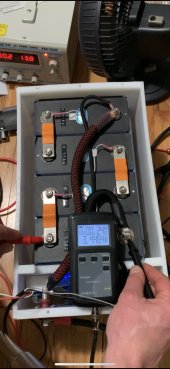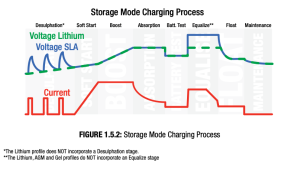T3TRIS
New Member
- Joined
- Feb 22, 2022
- Messages
- 28
Hello,
I built a 302Ah battery pack using 302Ah CATL grade A cells from EELbattery (if memory serves, the seller was recommended by Will Prowse at the time I purchased). The cells are connected using flexible busbars (same seller), they are dynamically compressed using die springs and 1/8 rubber in between cells.
The cells are monitored by an Overkill Solar 120A 4S BMS.
The cells were top balanced in parallel to 3.65V (multiple times at this point), under compression, using homemade 4AWG cables with hydraulically crimped lugs until less that 0.05A was going into the cells. They have been left connected together for hours before putting them in series.
They stayed close together until I did a capacity test using a 400W electronic load tester. The test was pulling 30A until 11V, 20A until 10.5V and 10A until 9.5V (which it'd never reach of course). The idea was to minimize voltage drop in the wiring (2ft of 6AWG) since this unit doesn't have voltage sense wires.
The BMS is set to stop discharge at 10V total or 2.5V per cell.
Cell # 2 reached 2.5V before the others, though I didn't see the voltage difference.
Then I set my 60A power supply to 14.2V (I was already afraid of cells going out of balance) and let it charge at 50A.
Cell #1 was getting close to 3.65V before the others (cell #3 was about 80mv behind, cells #2 and #4 were about 110mV behind). Cell balancing was happening but the Overkill Solar BMS can't balance at a high amperage.
I let it all sit for a few minutes and turned the power supply to 14.5V (which is what the charger Redarc Manager30 is set to) and turned the power supply back on.
This time, Cells #2 and #4 were ahead and about to hit 3.65V before the others. By this point there were all within 40mV, above 3.61V but still taking 6A.
Cell #2 triggered the BMS 3.65V charge safety parameter and charging stopped.
I let the cells settle, 40min later, cells #1 and #3 were around 3.38V and cells #2 and #4 were around 3.44V.
3hrs later, #1was at 3.348V, #2 was at 3.361V, #3 at 3.341V, #4 was at 3.354V (cell delta was 20mV).
I tried charging again and cell #2 and #4 once again took the lead and triggered the 3.65V limit. Settling looked the same.
This is basically what seems to happen in the rig, with the charger triggering the cell BMS safety parameter before the charger stops charging.
While it might seem like I'm just charging and charging, this stuff happened since the initial top-balance.
I just reconnected them in parallel and got them to 3.65V until they only took 0.05A again and left them connected in parallel. 10hrs later, they are now at 3.592V, still in parallel. I'm hoping this will be a solid top balance but all of this seems over-kill (I didn't have to do that for previous LiFePO4 batteries I built).
I'm going to reconnect the BMS and set the Redarc load disconnect to 11.4V (or theoretically 2.85V on average per cell). I'm hoping this will prevent cells going out of balance, but it also means getting farther away from the advertised capacity.
Additional info:
Cell impedance measurements were (in order): 24mΩ, 23mΩ, 22mΩ, 23mΩ.
I capacity tested each cell and they were all within 1.5% of one another (my 15A tester got close to 299Ah results, my 400W tester got closer to 292Ah results).
When I last top-balanced them to 3.65V, all the cells settled to 3.325V the following day, I thought that was low (charts seem to indicated that 3.325V is around 70% or 80% SOC for LiFePO4). The seller is saying this is normal.
Am I over thinking this? This battery is for a customer and I want to make sure it outlasts their rig!
I built a 302Ah battery pack using 302Ah CATL grade A cells from EELbattery (if memory serves, the seller was recommended by Will Prowse at the time I purchased). The cells are connected using flexible busbars (same seller), they are dynamically compressed using die springs and 1/8 rubber in between cells.
The cells are monitored by an Overkill Solar 120A 4S BMS.
The cells were top balanced in parallel to 3.65V (multiple times at this point), under compression, using homemade 4AWG cables with hydraulically crimped lugs until less that 0.05A was going into the cells. They have been left connected together for hours before putting them in series.
They stayed close together until I did a capacity test using a 400W electronic load tester. The test was pulling 30A until 11V, 20A until 10.5V and 10A until 9.5V (which it'd never reach of course). The idea was to minimize voltage drop in the wiring (2ft of 6AWG) since this unit doesn't have voltage sense wires.
The BMS is set to stop discharge at 10V total or 2.5V per cell.
Cell # 2 reached 2.5V before the others, though I didn't see the voltage difference.
Then I set my 60A power supply to 14.2V (I was already afraid of cells going out of balance) and let it charge at 50A.
Cell #1 was getting close to 3.65V before the others (cell #3 was about 80mv behind, cells #2 and #4 were about 110mV behind). Cell balancing was happening but the Overkill Solar BMS can't balance at a high amperage.
I let it all sit for a few minutes and turned the power supply to 14.5V (which is what the charger Redarc Manager30 is set to) and turned the power supply back on.
This time, Cells #2 and #4 were ahead and about to hit 3.65V before the others. By this point there were all within 40mV, above 3.61V but still taking 6A.
Cell #2 triggered the BMS 3.65V charge safety parameter and charging stopped.
I let the cells settle, 40min later, cells #1 and #3 were around 3.38V and cells #2 and #4 were around 3.44V.
3hrs later, #1was at 3.348V, #2 was at 3.361V, #3 at 3.341V, #4 was at 3.354V (cell delta was 20mV).
I tried charging again and cell #2 and #4 once again took the lead and triggered the 3.65V limit. Settling looked the same.
This is basically what seems to happen in the rig, with the charger triggering the cell BMS safety parameter before the charger stops charging.
While it might seem like I'm just charging and charging, this stuff happened since the initial top-balance.
I just reconnected them in parallel and got them to 3.65V until they only took 0.05A again and left them connected in parallel. 10hrs later, they are now at 3.592V, still in parallel. I'm hoping this will be a solid top balance but all of this seems over-kill (I didn't have to do that for previous LiFePO4 batteries I built).
I'm going to reconnect the BMS and set the Redarc load disconnect to 11.4V (or theoretically 2.85V on average per cell). I'm hoping this will prevent cells going out of balance, but it also means getting farther away from the advertised capacity.
Additional info:
Cell impedance measurements were (in order): 24mΩ, 23mΩ, 22mΩ, 23mΩ.
I capacity tested each cell and they were all within 1.5% of one another (my 15A tester got close to 299Ah results, my 400W tester got closer to 292Ah results).
When I last top-balanced them to 3.65V, all the cells settled to 3.325V the following day, I thought that was low (charts seem to indicated that 3.325V is around 70% or 80% SOC for LiFePO4). The seller is saying this is normal.
Am I over thinking this? This battery is for a customer and I want to make sure it outlasts their rig!







